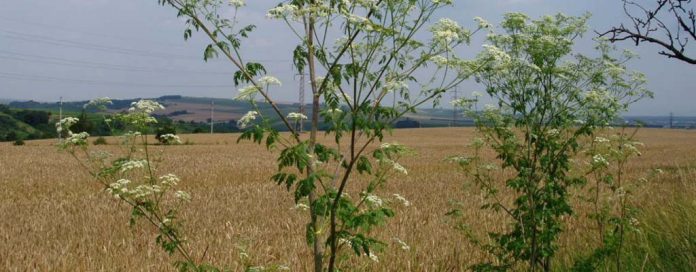It seems like one of those years when growing conditions start off great but then we move into dry and hot conditions at the peak of summer. With such conditions we will have an increased potential for livestock poisonings.
As summer progresses, the preferred forages for grazing dry up and become less available and animals are forced to consume plants they might otherwise not eat. Therefore, there are recognizable circumstances like drought, overgrazing, nitrogen fertilization and summer storms that all have the potential to contribute to livestock poisoning.
So what are some plants of concern for grazing livestock during these dry conditions in Ohio?
I’ll cover some of the culprits in our area.
Poison-Hemlock
Poison-hemlock, not native to Ohio, has become a naturalized throughout the state. This plant is easily found along roads, ditches and some pastures.
Poison-hemlock is a biennial and easily recognized by the parsley like leaves, purplish speckled stem and from the second-year development of clustered white flowers.
This is a tall plant and can reach 8 feet in height. All parts of the plant contain toxic substances that cause respiratory failure in humans and animals if ingested.
The toxicity of this plant changes little in hay — fresh or silage.
Buttercup Beautiful
Small yellow flowers are common in pastures. Buttercup starts blooming in June and produces many typically bright yellow flowers of five or more petals with flowers spreading to 1 inch in width.
Tall buttercup and creeping buttercup are very aggressive perennials in pastures and can quickly overtake the field.
Buttercup contains a bitter, irritating oil called protoanemonin that is poisonous to livestock. The toxicity is reported to vary depending on plant age, growing conditions and freshness of the forage.
The oil in fresh plant stems cause irritation and blistering of the skin, lining of the mouth and of the digestive tract.
Thankfully, buttercup does not taste good so animals avoid it if possible. In dry conditions this may be one of the few green plants available and livestock are more likely to eat it.
The toxic oil evaporates quickly, so hay containing buttercup is not toxic.
Nightshade
A family of plants in eastern Ohio, horsenettle, groundcherry, black and bittersweet nightshade are most common.
Some quantity of nightshade can be found in many pastures and are usually left alone. Consequently, nightshade populations slowly begin to occupy larger and larger portions of a pasture.
During a drought livestock will consume the leaf and berries of these plants which can be deadly.
Dogbane and Milkweed
These are closely related perennial plants commonly found in pastures and hay fields.
If you have ever removed a leaf from these plants you will notice a very sticky white milky substance. The leaves and stems of these plants are considered toxic when fresh or dried.
These plants don’t mind a little dry weather and consequently become more attractive to livestock during these conditions.
Jimson Weed
A summer annual that looks more like a small shrub with a reddish stem. You often see this plant around brush piles, hay feeding areas and barn lots.
The fruit of this plant is encased in a very sharp and spiny outer covering. The leaf is large, waxy and looks something like an oak leaf.
This plant is very common and not often eaten. The tropane alkaloids in this plant and seeds are considered extremely toxic when fresh, dried or in silage.
Black Locust Tree
The black locust is a common and fast growing tree. It has sharp short spines and small, oval, fern-like arrangements of leaves.
It is common along fence rows and livestock may have grazed in these areas for years with no apparent problem. In dry conditions root sprouts can become prominent in adjacent pasture fields.
Young inquisitive animals may find this plant palatable. The bark and new growth are the most toxic.
Wild Black Cherry
The black cherry tree is well established in Eastern Ohio. This tree is very common and potentially very lethal to pastured livestock.
During summer, thunderstorms often damage limbs which break off and fall into pastures.
Livestock are most often poisoned from consuming the wilted leaves that contain a hydrogen cyanide toxin which can quickly kill grazing animals.
Inspect pastures frequently after storms and remove broken limbs immediately.
Yew or Taxis evergreen shrubs
So you needed to trim the bushes, and you thought you would help the livestock by providing a little extra fodder? Hope it wasn’t a yew.
These evergreen shrubs with flat needles and a red berry are readily consumed by livestock and are highly toxic. These shrubs are poisonous wet or dried.
Be aware of toxic plants
As we move into dryer conditions be aware of your forage availability and identify plants which may be of concern.
We have only mentioned a few plants and there are many you should know.
Watch your livestock closely and daily, observing for signs of distress. Contact a veterinarian immediately if you suspect plant poisoning.
If we can help you identify plants of concern please give your local OSU Extension office a call.














Unfortunately I discovered plant toxicity the hard way. Over grazing, dry weather nor storms caused the problem. My husband and I opened up a new lush pasture that enclosed a bit of a wooded area that contained numerous wild cherry trees. Two dead sheep later I noticed much of the bark was stripped off of many of the young trees. I had an autopsy performed and there was no evidence of parasites or disease. I am convinced the bark of the wild cherry is deadly to sheep. Needless to say we closed off that part of the pasture and removed all of the trees.